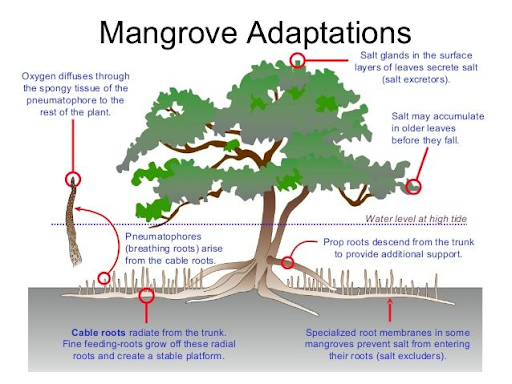Mangroves
About
- A mangrove is a shrub or tree that grows mainly in coastal saline or brackish water.
- Found in tropical and subtropical regions, mangroves are known for their salt-tolerant vegetation (halophytes).
- Mangroves belong primarily to the families Rhizophoraceae, Acanthaceae, Lythraceae, Combretaceae, and Arecaceae.
MISHTI:
|
Adaptation Mechanisms
- Many mangroves characteristically have prop roots descending from the trunk and branches, providing a stable support system in the submerged conditions.
- Many mangrove species survive by filtering out as much as 90 percent of the salt found in seawater as it enters their roots.
- Some mangroves have pencil-like roots called pneumatophores that grow out from the water surface that facilitate the aeration necessary for root respiration.
- Mangroves, like desert plants, store fresh water in thick succulent leaves. A waxy coating on the leaves seals in water and minimises evaporation.
- Mangroves are viviparous, their seeds germinate while still attached to the parent tree. Once germinated, the seedling grows into a propagule. The mature propagule then drops into the water and gets transported to a different spot, eventually taking root in a solid ground.

Significance of mangroves
- Mangroves serve a multitude of purposes in their ecosystem, including coastal protection, filtration of water, and disaster risk reduction.
- Mangrove forests stabilize coastlines, reduce erosion, encourage biodiversity growth, and shield coastal communities from sea-level rise, and natural disasters like hurricanes and cyclones.
- Mangroves are also one of the most carbon-rich forests of the tropics, storing carbon from the atmosphere at up to four times the rate of terrestrial forests.
Distribution in India
- West Bengal (Sundarbans) has the highest percentage of mangrove cover in India. It is followed by Gujarat and Andaman, and Nicobar islands. Maharashtra, Odisha, Andhra Pradesh, Tamil Nadu, Goa and Kerala too have mangrove cover.
Threat to mangroves
- Agriculture, overfishing, and rapid urbanisation are some of the glaring threats to mangrove forests around the world.
- Indirect threats to mangroves include change in sedimentation rates and patterns, rising sea levels, and increase in pollutants, and these are often exacerbated by human actions.
Subscribe
Login
0 Comments
